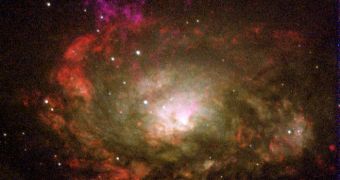Astrophysicists recently conducted a new investigation of a special class of objects in the Universe, called active galactic nuclei. They focused on a specific class of AGN, and were able to determine some interesting behaviors radiation emissions exhibit in close proximity to the structures.
Using the European Space Agency's (ESA) INTErnational Gamma-Ray Astrophysics Laboratory (INTEGRAL) spacecraft, researchers were able to determine that AGN affected by stronger absorption at lower energies produced an excess of radiations in the hard X-ray band.
The emissions were considerably more intense than those discovered in AGN were low-energy absorption was discovered to take place at normal levels. Experts are currently trying to find out whether the black holes and accretion disks that power active nuclei have something to do with this.
These structures are usually surrounded in thick clouds of neutral hydrogen gas, which can reflect X-rays. The new INTEGRAL studies targeted a specific class of galaxies containing AGN, called Seyfert galaxies, Daily Galaxy reports.
These objects are characterized by the fact that they contain AGN which produce spectral line emissions from highly ionized hydrogen gas. The cores of Seyfert galaxies are usually powered by supermassive black holes weighing between 107 and 108 solar masses.
The ESA telescope was trained on a sample of 165 such galaxies, and determined that the differences in low-energy radiation absorption lead to excessive X-ray emissions. Most likely, experts say, the X-rays are reflected off the same hydrogen clouds that absorb less low-energy radiation.
“The unified model predicts that all AGN exhibit the same behavior when observed at hard X-ray wavelengths, regardless of the different emission they might show in other bands,” Claudio Ricci says.
“Absorption by the torus is weaker for photons with increasing energy, and it should have no effect at all, for the objects in our sample, on the hard X-ray photons probed by INTEGRAL,” he adds.
Riccis is a PhD student at the University of Geneva's Data Center for Astrophysics (ISDC).
“A significantly stronger reflection in a certain class of AGN indicates that the environment of these objects is different,” adds the ISDC INTEGRAL principal investigator Roland Walter, who is also a coauthor of the new study.
“The discrepancy in the high-energy emission properties of different AGN types is unaccounted for in the leading theoretical framework and calls for a rethinking of some of its details,” the expert explains.
Walter concludes by saying that the new study indicates various classes of AGN to have different patterns of radiation-absorbing material distribution, which influence their emission of high-energy radiation.

 14 DAY TRIAL //
14 DAY TRIAL //